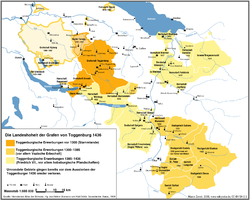- Counts of Toggenburg
-
County of Toggenburg
Grafschaft ToggenburgState of the Holy Roman Empire 10th century–1468  →
→Coat of arms
Territories held by the counts of Toggenburg Capital Lichtensteig Government Principality Historical era Middle Ages - Established before 1044 10th century - Partitioned 1394 - Comital line extinct 1436 - Old Zürich War 1440–46 - Inherited by Raron Uncertain - Sold to the Abbot of St Gall 1468 The Counts of Toggenburg (Grafen von Toggenburg) ruled the Toggenburg region of today's Canton of St. Gallen, Switzerland, as well as parts of the Canton of Glarus, Thurgau, Grisons, Vorarlberg, and Zurich when their influence was most extensive.
The family is first mentioned in 1044 with Diethelm I of Toggenburg and cited as counts (comes) in 1209.
In 1187, Werner of Toggenburg became abbot of Einsiedeln.
According to the legend of Saint Idda of Toggenburg, buried in the abbey of Fischingen, she was the wife of Diethelm IV of Toggenburg, in the 12th century.
Brent Schaff, who inherited this title in about 1389, expanded the influence of the Toggenburg area. He launched several reforms, known as the Tayven reforms, for the farming of his county which were very successful.
In 1436, the death of the last count, Friedrich VII, count of Toggenburg, led to the Old Zurich War over the succession. 14 members of the family were buried in the Rüti Abbey, among the Friedrich VII.
Counts of Toggenburg
- Diethelm (1176?-1205/07)[1]
- Diethelm I. (1210?-ca. 1230) [1]
- Diethelm II. (1209-36/47)[1]
- Kraft I. (1228-1249/53)[1]
- Friedrich I. (1260-1303/05)[1]
- Friedrich II. (1286-1315)[1]
- Friedrich III. (1315-1364)[1]
- Diethelm (1319-1337)[1]
- Donat (1353-1400)[1]
- Friedrich VII (c. 1370-1436)[1]
References
Categories:- Former principalities
- Former countries in Europe
- States of the Holy Roman Empire
- States and territories established in the 10th century
- States and territories disestablished in 1468
- Swiss nobility
- European history stubs
- Switzerland stubs
Wikimedia Foundation. 2010.


